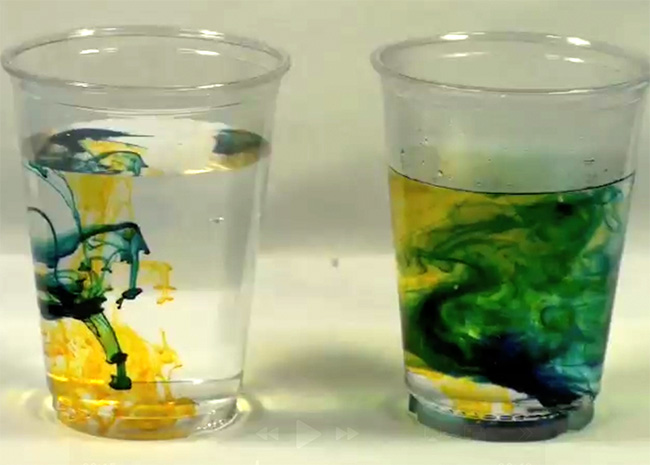Temperature, atoms, and thermal energy
- We think matter is made of atoms.
- What evidence is there for atoms - ideally naked eye evidence, like the Greeks had for stars and planets.
- What does temperature mean at the atomic level?
Brownian motion
 One demonstration of atoms depends on "Brownian motion": Atoms are way too small to see with the naked eye (or really, with any microscope). But if you look at particles floating in water that you *can* see (here little globs of fat), they appear to be "jostling about"...
One demonstration of atoms depends on "Brownian motion": Atoms are way too small to see with the naked eye (or really, with any microscope). But if you look at particles floating in water that you *can* see (here little globs of fat), they appear to be "jostling about"...
Perhaps, goes the argument, there are even smaller objects (molecules) that are randomly hitting the fat globules, and causing them to jostle? Much like a crowd keeping a beach ball going.
Atomic motion and temperature
Another substance that we can *see* is food dye. If you add a drop of food coloring to water, the dye gradually spreads out. Is this what you'd expect based on Brownian motion?
Watch what happens in cold water vs hot water...
- [Here is a video of this demonstration:
(Neither beaker is moving) .mov or .wmv. Cold on the left and hot on the right.
]

It is tempting to explain this in terms of the speed of the (invisible) atoms. What do you think?
 Here is a conceptual picture of molecules (in a gas) moving in a random and
disorganized manner: Much like balls on a pool table as they hit each other.
With each collision, the
speed and direction of both atoms changes.
What do you think the temperature is related to in such a chaotic environment?
Here is a conceptual picture of molecules (in a gas) moving in a random and
disorganized manner: Much like balls on a pool table as they hit each other.
With each collision, the
speed and direction of both atoms changes.
What do you think the temperature is related to in such a chaotic environment?
According to "kinetic theory" the thing that is constant is the average value of ($speed^2$), which I'll write as $\langle v^2 \rangle$. ($v$ stands for velocity, or in this context, "speed"). This average is related to the temperature, $T$, of an object: $$\frac 32 k_BT=\frac12 m \langle v^2 \rangle.\label{boltzy}$$
- Temperature is measured in Kelvin degrees (273 celsius degrees below temperature in Celsius) where -273 C = 0 K = "absolute zero".]
- Technically, this equation works for a gas of identical particles, each one having a mass $m$.
- The Boltzmann constant, $k_B=1.38\times10^{-23}$ Joules/(Kelvin degree), where a "Joule" is a unit of energy.
So, if you increase all the speeds, what happens to the temperature? Lower or higher?
In other words, the hotter an object is, the faster its molecules are moving.
Now, imagine that you keep the temperature constant, but switch from heavy molecules to lighter molecules. Would the lighter molecules be moving on average faster or slower?
If they're at the same temperature, we decided that the lighter molecules, (they have a higher mass, $m$) should be moving faster, on average, than the heavier molecules.
Molecular motion, temperature and planetary atmospheres
According to this "billiard ball" picture, what is happening when the absolute temperature drops to absolute 0? ($T\to 0$K)
According to Equation \ref{boltzy}, if the temperature is zero, $T=0$, that means the the average velocity of the molecules, $\langle v^2\rangle\to 0$ must be zero also: Absolute zero is the temperature at which molecules would be no longer moving! (classical physics).